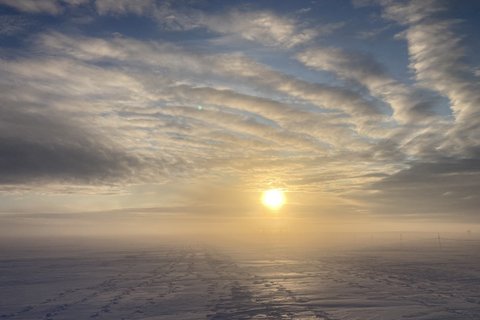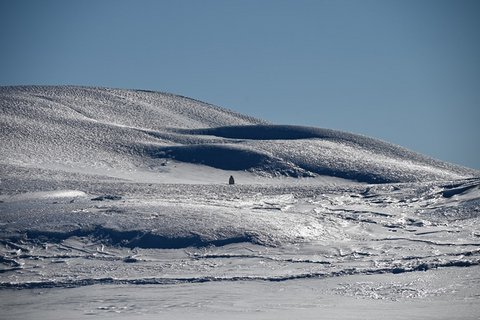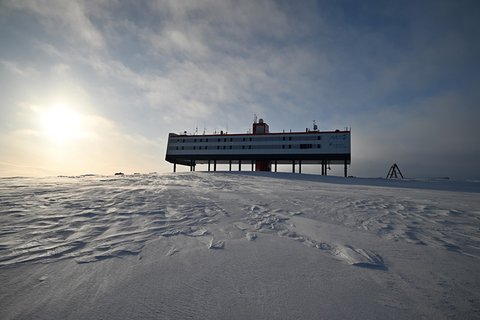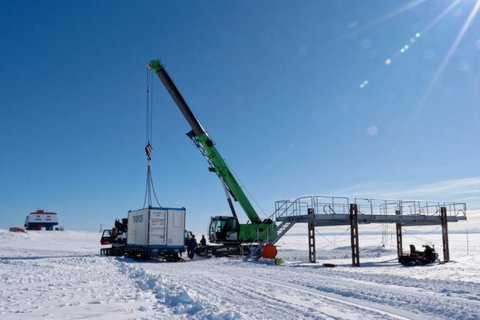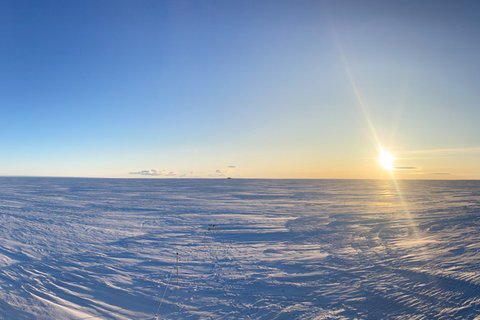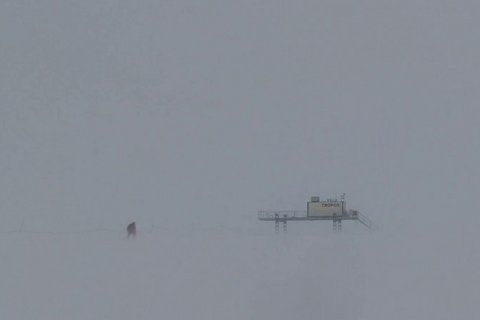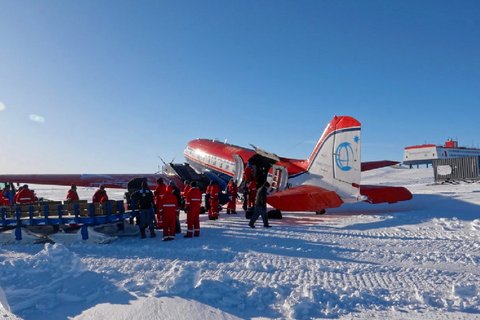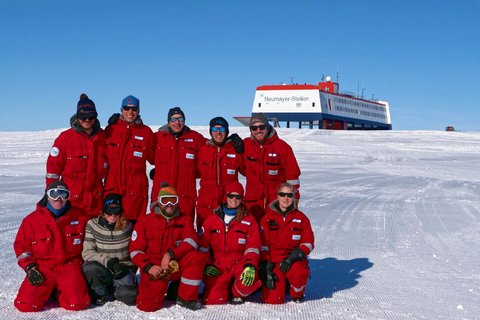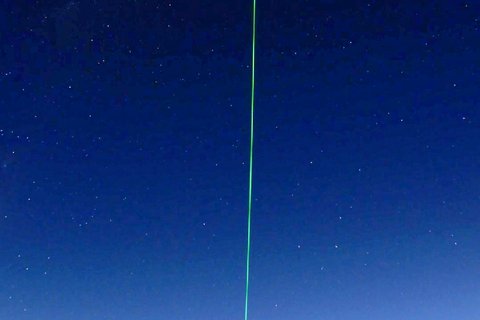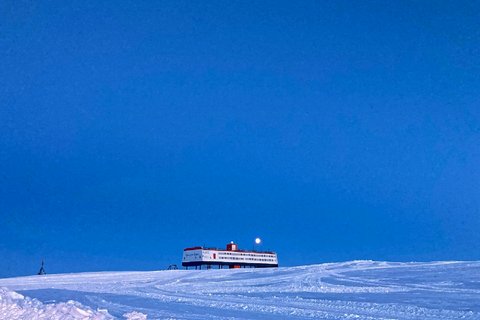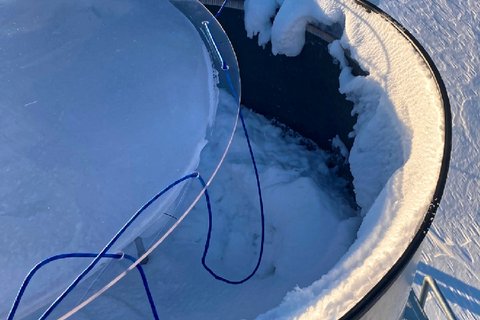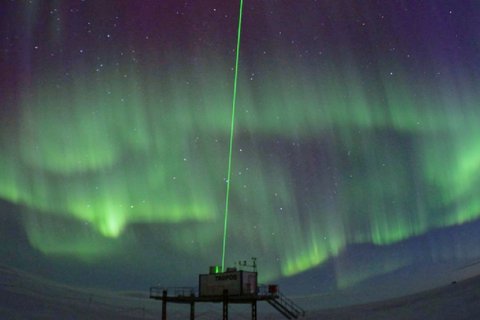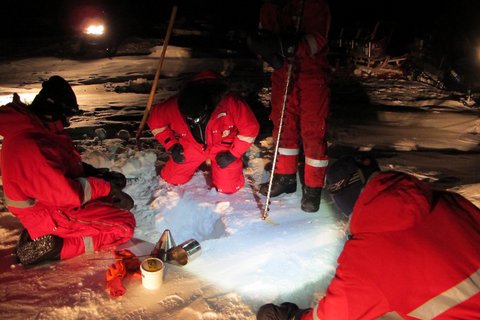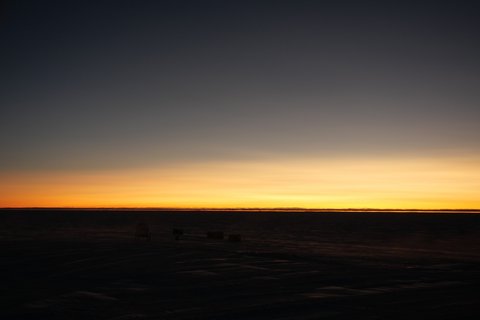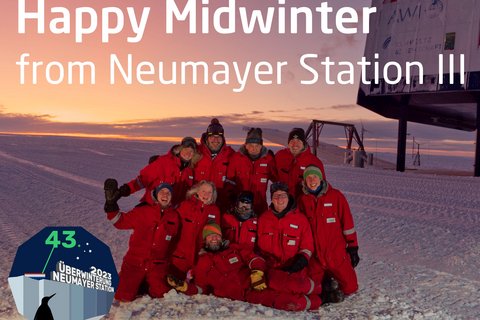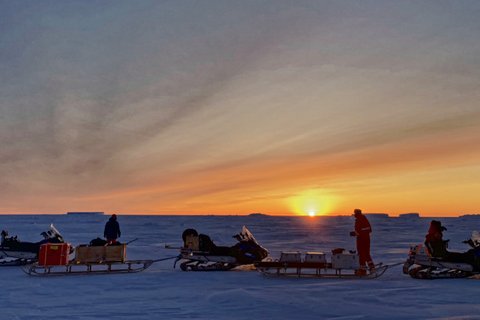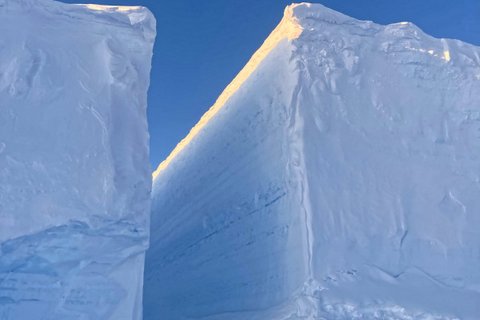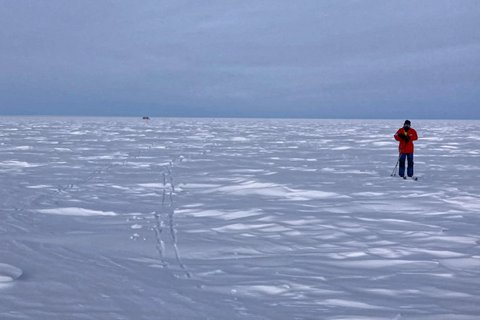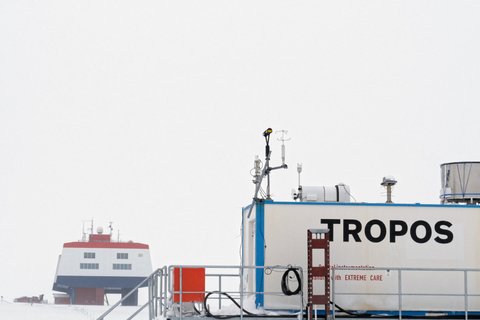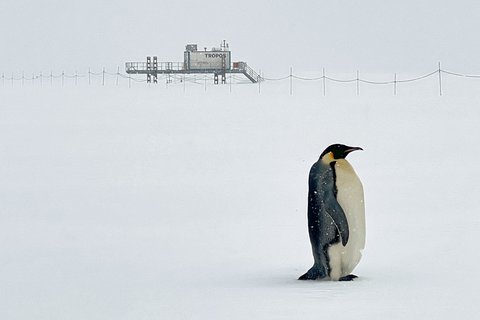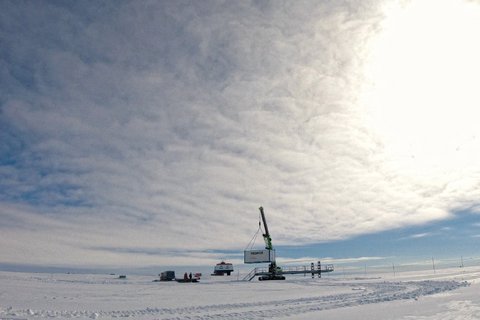About COALA
COALA – Continuous Observations of Aerosol-cLoud interaction in Antarctica
Neumayer III Station, Antarctica
There are still many unanswered questions about the interactions of aerosol particles with radiation, clouds and precipitation. This is especially true for the remote region of Antarctica, where ground-based, vertically resolved long-term observations of aerosol, clouds and precipitation are rare and satellite observations provide only an incomplete picture. To fill this measurement gap with state-of-the-art observations, TROPOS, in collaboration with the Alfred Wegener Institute, will deploy the "OCEANET-Atmosphere" measurement platform between the austral summers of 2022/23 and 2023/24 at Neumayer III Station (70.67°S, 8.27°W). "OCEANET-Atmosphere" is an autonomous, polar-tested, modified 20-foot measurement container that was recently successfully deployed during the 2019/20 North Polar Drift of the "Polarstern" expedition MOSAiC (Multidisciplinary drifting Observatory for the Study of Arctic Climate). OCEANET is the only single-container, mobile polar platform that uses multi-wavelength lidar, radar, and microwave radiometer to observe clouds and precipitation, and Doppler lidar and radar to observe turbulent air movements in clouds. Observations in 2023 will primarily be used to investigate COALA's key hypothesis of how aerosol transport from Southern Hemisphere mid-latitudes affects cloud processes and precipitation along the coast of Antarctica.
Reporting from "Neumayer III" are Martin Radenz (MR) and Ronny Engelmann (RE) from the lidar group of TROPOS.
Arrival and acclimate
Happy new near from Antarctica!
Finally, after almost a year of preparatory work, the observational phase in Antarctica is about to begin. Our setup team consisting of Ronny Engelmann and Martin Radenz traveled to Neumayer Station mid of December. The flight organized by the Norwegian Polar Institute took us more or less directly to the blue ice runway at Troll Station, where we switched to a ski-equipped plane for the final stint to Neumayer on the Ekstrom shelf ice.
The first days were spend on acclimatization and finding our ways around. Suddenly there was Christmas eve, where we altogether had a nice dinner and a small party afterwards. New Years Eve was celebrated with a an outdoor Kubb tournament and some snow sculpturing. Now we are awaiting the arrival of Polarstern, from our point of view this time in the role of a resupply vessel, delivering the OCEANET-Atmosphere container. In the meantime, we coordinated the setup planning with the logistics team and prepared some bits of data acquisition software. The only instrument we could set up for a test is a snow particle counter borrowed from the British Antarctic Survey, which arrived via air freight.
Fingers crossed, that the contain will arrive soon and in good shape.
Setup of Oceanet (27 January 2023)
The last days have been packed with work and went by like a breeze. We will try to give you an overview…
After 3 weeks of (mostly) waiting including a brief Christmas and New Years celebration, Polarstern arrived with our container (an a lot more) on 6th of January on the edge of Ekstrom shelf ice.
Within two and a half days dozens of containers, a wind power plant, and other supplies were lifted on the ice.
From there all the material had to be pulled with Pistenbullys and sledges to Neumayer III, which is located roughly 20km onshore, floating on a 200-something m thick piece of ice and snow.
On the first glimpse our Oceanet container survived the 5-month transport quite well, especially when considering the >8m waves on the final leg from Cape Town to Antarctica.
It took another couple of days to get cargo and logistics sorted, before the construction team could take our container to the former EDEN platform, which is located 300m south of the actual station.
On the morning of January 12th, the sledge was pulled to the platform, the crane arrived and lifted Oceanet onto it’s home for the coming year.
We started immediately to get the electricity connected and started to assemble the hardware.
After several very long days all the instruments were installed and all cables connected and tied to structures that seem stable enough to withstand the Antarctic winds.
When putting the measurements to work, we got an idea that it must have been a tough journey indeed. The radar high voltage power supply initially made some strange noises, but meanwhile it seems to run well with reduced power.
The new Diode-pumped laser inside Polly also did not deliver the power we expected, but after a day of realignment and adjustments it decided to put out some more light.
Once sufficiently operational, we were asked to provide some guided tours for the all the other persons. Just in time for Ronnys departure we also gave an evening science talk on Tropos, the ground based remote sensing group and our work from all over the world – including of course our project down here.
Last Wednesday Ronny left for Troll with Polar 5, to catch his intercontinental flight to Cape Town, where he meanwhile arrived.
Today, we experienced 49kts of wind (10m, 1min average) and our installations seem to cope quite ok. However, as one of the former overwinterers put it “Compared to winter storms, everything in summer feels boring…” (MR)
Departures (6 March 2023)
Time at Neumayer Station flies and winter is approaching rapidly. The nights are getting longer (>9h) and colder (-23 this morning). With the upside, that it is now dark enough to see Pollys Laser. The bustling summer season came to a (mostly) successful end.
Last Thursday, the last scientists and logistics support, flew to Troll Station with Polar 5 to catch the last intercontinental flight to Cape Town. Suddenly the number of occupants at the station reduced from forty-something to the 10 person winter team. Especially during the nights the station can feel frighteningly empty and silent.
On Friday we had our very last visitors: Polar 5 came in from Troll and had to leave the continent via Rothera to Punta Arenas. Originally they planned to stay one night, but the weather window was too appealing and they decided to continue as soon as possible. In a joint action, we unloaded the final freight (including Oceanet spare parts) and some fresh food (Bananas, pineapples, oranges, …), dismounted the passenger configuration, refueled the plane, loaded Ken Boreks maintenance materials, and the Basler 67 took off after less than 3h on the ground.
Polar 5 was also the last plane to leave Dronning-Maud-Land at the end of the summer, which is now only inhabited by roughly 120 people at 6 year-round stations, scattered over 2.7 Mio km² (7.5 times the area of Germany).
In the next few days, we will continue to prepare the surrounding of the station for the winter. The cabooses from the summer camp (where also Ronny lived) have to be cleaned, sealed, and brought to the winter storage area. Otherwise even more of the drifting snow will accumulate around the station. So far, the instruments at the Oceanet Container are running quite fine.
Best regards from 70S
Martin
Autumn (25 April 2023)
Since seven weeks we are now ‘alone’ at the station and routine starts to settled in.
My day is filled with checks of instruments and data at the Oceanet-Container, fixing hardware issues (more below) as well as supporting the station meteorologist with SYNOP observations and radiosondes. Additionally, there a quite a lot ‘non-scientific’ tasks, which are tackled by the whole team: monthly fire-drills, redistributing snow, weekly cleaning the station, doing the dishes, and so on… Right today, there are still 6:50 h of daylight, but each day is a quite a bit shorter than the previous one – polar night is less than a month away.
Weather is quite variable. Usually there are a couple of days with strong winds, mostly with snowfall, followed by a few days of calmer conditions, frequently with supercooled liquid clouds, sometimes with clear sky. Speaking of strong winds, during the last week of March we experienced the strongest storm so far. Almost 10 days with wind speeds above 40 knots, peaking at 70knots on March 26th (10m, 1min average). At the Oceanet container, most of the instruments did cope quite well. Nothing got blown away, but the radome of our MIRA cloud radar is a quite efficient snow collection tool, if the winds are strong enough to vibrate the cover. Winds dropped on April 3rd and with the help of the station meteorologist, we were able to remove snow and ice from the antenna (one of the attached pictures shows the cover partly removed). Luckily no permanent damage was caused and after tying down the cover even more, the MIRA is doing quite fine since.
We celebrated Easter with a mulled wine in front of the station. That night, the temperature dropped below -27°C for the first time. But since then, April is warmer and moister than usual, with a lot of supercooled water being attached to any kind of superstructure. One of the favored locations seem to be the mobotix webcam on top of the container.
Chances for observing polar lights were quite rare during the last few weeks, especially compared to Germany. Moist air masses also means clouds, most of the time combined with drifting snow. Actually, the last ‘good’ event was back in March. Nonetheless, it’s still not polar night yet, so there should enough occasions left – if we are luck to find a gap in the clouds.
Best regards from 70S
Martin
Midwinter (21 Juni 2023)
Hi everybody,
we are halfway through polar night: happy mid-winter!
‘Night’ is quite relative, as Neumayer is still far enough north to receive a few hours of twilight (bürgerliche Dämmerung), even at winter solstice.
The sun, slightly below the horizon nicely illuminates the stratospheric aerosol layers. I tried to capture the beautiful colors into pictures, but the reality is more stunning :)
Temperature ranges between -38C on calm, cloud-free days and around -20C on windy days (as today 50kts sustained wind and strong blowing snow).
Earlier this week we did our second sea ice measurement day. Once a month the thickness of the sea ice in Atka Bay is measured by drilling holes at 6 positions along a transect.
With the farthest point being 35km from Neumayer, this is an eleven hour round trip by skidoo.
Ice thickness ranges from more than 3m in the rafted eastern part of the bay down to 70cm in the western areas.
Enjoy the summer!
Cheers,
Martin
Summer just around the corner (24 October 2023)
Since the sun came back over the horizon in late July, time seems to pass even faster. Maybe, the reason a combination of routine task, but quite a lot of them, that keep us busy. Removing snow and ice from instruments, un-digging anything that’s covered by drift (ranging from the snow particle counter up to Pistenbullys), manual collection of snow samples, regular sea ice thickness transects, cleaning the station, monthly fire drills, checking data, repairing instruments, changing a motor of our power supply (not so routine though), more snow shoveling, …
The routine is only interrupted by social events, especially birthday parties. As a custom, a gift is crafted for the ‘birthday child’ with whatever materials are available at the station. Boundless creativity produced, miniature traffic signs, custom-fitted escape games, mock sailing dinghy’s and many more. The very day usually starts with a collective brunch, some singing and handing over the gift. After the days labor, there might be a party in the evening. Another favored leisure activity is skiing. Though the recreational value depends a lot on snow conditions, temperature and wind. As with almost everything, the border to work is not sharp: on days with deep, soft snow, skis also provided the only reasonable means of transportation to the container, met-tower, air chemistry observatory or magnetic observatory.
Summer season is approaching rapidly, noticeable by the meanwhile quite long daylight – 18 hours and increasing. The first spring storms already passed, again with gusts exceeding 70knots, preparing the transition to summer climate. The station is awakening from hibernation: containers are retrieved from winter storage, the runway is in preparation, all the common spaces and sleeping areas are prepared for the summer personal. It’s going to get more crowed here, but we are excited to see some new faces again. Weather permitting, the first small planes will arrive from South America via Rothera end of this week. The first intercontinental flight with summer scientists and technicians is scheduled for early next week.
Best regards from 70S
Martin
PS: The OCEANET measurements are also covered in the current piece of the AtkaXpress: The Riddle of the Green Beam > https://blogs.helmholtz.de/atkaxpress/en/2023/10/the-riddle-of-the-green-beam/
PPS: If you want to know what Spuso or Magobs mean: At https://blogs.helmholtz.de/atkaxpress/en/2023/10/a-glimpse-into-day-to-day-life-at-the-neumayer-station-iii/ there is a small glossary of typical Neumayer III terms .-)
Ending the COALA observations ( 08 January 2024)
The summer season started with a slight delay, as the flight had to be postponed due to unfavorable weather conditions. As soon as the technicians and scientists arrived, the work began right away. The station was raised above last year’s snow accumulation. An intensified science program commenced with additional personal. During the first 7 weeks of the season, the focus was on sea ice physics as well as biology and the Emperor Penguin colony. This year also Kohnen Station, which is located inland on the plateau, is also open. This required a Pistenbully traverse starting from Neumayer with personnel and resupplies. Of course the work of the observatories (meteorology, air chemistry and geophysics) and the OCEANET container continued.
Ronny arrived by the intercontinental flight a week before Christmas to support the dismantling and packing of OCEANET. Before that, the ship with the bulk of the resupplies arrived at the edge of the ice shelf. All hands were needed to unpack, sort and stow the huge quantities of food, consumables and spare parts. We managed to complete the most urgent tasks just before Christmas, so that all the fresh food and goodies were available in time. After Christmas, we had to begin the disassembly of OCEANET container: dismounting the cloud radar antenna from its radome, collecting the snow particle counter, removing all the small instruments and cables from the roof, moving the Doppler lidar housing into the container and finally strapping down everything. After a few long days, we were finished in time for New Year's Eve.
As almost a year ago, the green crane arrived to lift the container – this time from the platform to the sled. Now OCEANET is waiting the second ship call of the season, which will take it via Cape Town to Bremerhaven, where it should arrive end of February. Ronny and I will spend the remaining time at Neumayer with paperwork, reports and supporting the meteorological observatory. Our flights are scheduled for two weeks from now, but as always: there are no fixed plans in Antarctica.

